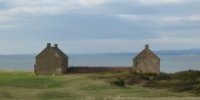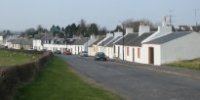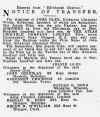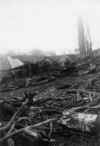 |
 |
 |
 |
Articles |
 |
Copyright notice: Links to this site are welcomed. However none of the material on the site may be duplicated in any form. The copyright of the articles is the property of the authors. Copyright of the web pages is the property of David McClure. |
Kilkerran Pyroligneous Acid Works 1845 to 1945
by David Courtney McClure
IntroductionThe Water of Girvan rises in the rocky hills and conifer plantations of the Carrick Forest, and enters a valley of farmland and broad-leaved woodland about Straiton, through which it winds first in a northwesterly direction towards Kirkmichael, and then in a southwesterly direction towards the sea at Girvan. According to Aiton (1811) "the strath of the water of Girvan, from Straiton to the sea, is highly ornamented with extensive plantations, to which very considerable additions are made every year. There are about 800 acres of woods and plantations on the estate of Kilkerran, and Sir Hugh Hamilton Dalrymple is adding 100 acres yearly to those at Bargeny [sic]".(1) There is little industry in this pastoral and sylvan setting today, though traces remain of its industrial past: the many mills, lime works, tile works and coal works. Amongst these the acid works at Kilkerran are at first sight an oddity, particularly under the description they were sometimes given, the Kilkerran Chemical Works. But they grew as much from the local resources as any of the mines, mills or kilns, because their raw material was the abundant timber. Pyroligneous AcidPyroligneous acid is obtained by the dry distillation of wood. This is a development of the traditional process of charcoal burning - by which is meant the burning of wood in an airless condition so that it is reduced to charcoal, rather than to carbon dioxide, water vapour and ash. Arthur Ransome provided a romantic description of the process and of charcoal-burners in Swallows and Amazons (chapter 13), from which the following are brief excerpts:
In the process of wood distillation, a chamber of firebricks or iron is substituted for the mound of earth, and a device is added to collect and cool the vapours released to condense them.(2) The condensate consists of pyroligneous acid and a tarry residue which separates from it and settles on cooling. The principal constituent of the acid is acetic acid. In the present context, this was used to manufacture sodium acetate, required in the process of dyeing cloth as a mordant, or fixative. Acetic acid obtained in this way from wood was cheaper than that produced from malt vinegar. A byproduct of the process is charcoal. According to Hume (1974), acetate mordants were produced from pyroligneous acid from about 1820.(3) A monograph produced by the British Society for the History of Science lists three companies producing pyroligneous acid.(4) The earliest was H. Ogden, operating in the northeast of England. Stills for the production of pyroligneous acid were introduced here in 1826, while in 1839 S. Warburton & Sons were engaged in the same business at Hunslet, near Leeds. Elsewhere it was being produced by the Forest of Dean Chemical Works, where there were eight retorts in 1841. [Note added in January 2010: For more information on a wood distillation plant see Roger Deeks, 'The Wood Distillation Works and Munitions Supply in the Great War', The New Regard: The Journal of the Forest of Dean Local History Society, 24, 2010, 6-18. Reference supplied by Rob Close.]
Turnbull and CompanyA pyroligneous acid works was established about 1813 in Camlachie Street, Glasgow, by Turnbull & Ramsay, linen printers’ colour makers.(5) The works were shut down in 1965 and demolished in 1967. A little of the changing names and operations of the company can be traced through the entries in Post Office Glasgow Directories. The earliest entry found was in 1825: "Turnbull & Ramsay, manufacturing chemists, 107 Geo. St." By 1831 the company was "Turnbull & Co., manufacturing chemists and vinegar makers, 229 George St.; works, Camlachie." Camlachie continued to be the only works listed until 1888-9, when the entry was: "Turnbull & Co., manufacturing chemists, 37 W. Geo. St.; works, Camlachie; branches, Balmaha, Crinan, Kilkerran, Perth, Renton, and Stirling." Kilkerran still appeared in 1892-3 but was later omitted, and in 1902-3 the entry included only Camlachie and Balmaha. By 1932-33 the company’s description had become "wood distillers and blacking millers" and their telegraphic address was "Pyros, Glasgow". In 1942-3 the company was "Turnbull, Stuart & Co. (Camlachie) Ltd."
Kilkerran Pyroligneous Acid WorksThe works were located at National Grid Reference NS303053, beside the road from Maybole to Girvan that winds on the northwest side of the valley of the Water of Girvan. This spot is in the parish of Kirkoswald though remote from Kirkoswald village. The site lies between two burns that flow swiftly down steep glens: on the Maybole side, Lyingthorn Burn; and on the Girvan side, Black Glen. A dam on the burn in Black Glen above the works provided power for a sawmill. The earliest record of the acid work at Kilkerran is the following lease:
According to the 1851 census the "Pyroligneous Acid Maker (Manager)" was James Aird, who was 46 and was born in Cumnock.(7) He employed six labourers. In the 1855-6 Valuation Roll Turnbull & Co. are shown as the tenants; the proprietor was Sir James Fergusson of Kilkerran.(8) "Kilkerran Acid Works" appears on the first Ordnance Survey map of the area (1856).(9) By 1861 James Aird had been succeeded by John Durham. It was under his management that effluent from the works polluted the river and killed "large numbers of fish".(10) In 1881 the manager was Hugh MacAdam, and in 1891 David Glen. From the 1897-8 Valuation Roll, in which he appears as tenant at nearby Wee Craigfin and described as "ex-manager", it may be that David Glen’s father George was manager of the works for some time between 1881 and 1891.(11) In 1893 an agreement was entered into for the Glasgow & South Western Railway Company to erect a "cartbridge" over the railway at the works in lieu of an existing footbridge. Mr Glen agreed to give up his level crossing.(12) In 1895 Turnbull & Co. gave up their lease of the works, and David Glen entered into a lease on his own account. Whether the product was sold by Glen to the company or went elsewhere, no surviving records have been found to say, but living memory has it that the charcoal was always shipped from Kilkerran railway station to Glasgow. Included in the lease was the dwelling house occupied by the various managers since 1845, and a field.(13) Also filed with the lease is an 1898 "memorandum of agreement" for "an improvement of the dwelling house which [David Glen] states is in a very bad condition", under which Glen was to pay half the cost. The period following the assumption of the acid works’ lease was a tragic one for the Glens. David Glen’s wife, Mary McCallum, died in 1898; his mother, Susan Glen née Davidson, died in 1900; and his eldest son George died in 1902.(14) He continued to hold the lease until his death on 4th November 1910 at the age of 54. His daughter Elizabeth died just a year later, age 27. It was his second son John who became the tenant, but he too died young, age 39, on 19th December 1922. One local memory is that he had a fondness for the wood alcohol which was one of the byproducts of the wood still.(15) Alternatively, it may be that he had contracted tuberculosis. A past addition to the house is an airy bay window, and it is said this was for someone with that condition. The new tenant was John’s wife, Jeanie Glen (née Baird). She ran the works until 1945, when she went to live in Maybole. She died on 4th October 1949 and was buried beside her husband in Crosshill Cemetery. She is remembered as a short, stocky woman with a fierce manner. She is said to have worked very hard and to have engaged little in the social life of the neighbourhood, though she was staunch member of Crosshill Church. One story told of her is that (David) Gordon, her eldest son, chided her about the way she was speaking to the men. "You go into the house," she told him, "I have to speak to the men in the language they understand."
William McIlwraith, now 88, was a boyhood friend of the Glens. He remembers that Mrs Glen took her sons to London every year when, she said, she had a meeting with the Chairman of ICI to renew her contract. When they returned, he and their other friends would hear of the sights they had seen, and of their visits to museums and art galleries. Mrs Glen was determined to give her sons a good education. After the primary school at Kilkerran and Ayr Academy, both boys went to Glasgow University, where Gordon studied Arts and then Theology, and Jack studied medicine.(16) David Gordon Glen graduated in 1936 and became a minister, though he turned to teaching later and had a post in Dalmellington. John (Jack) Glen graduated in 1938, after which he spent a year taking a Diploma in Public Health.(17) There must have been fond memories of their home; within the last decade relatives have returned to the old acid works to scatter the ashes of one of the sons and his wife in the garden there. In 1945 the tenancy of the works was taken by Atlas Crucible Company. The house was occupied by George Campbell, who may have been employed by the company. There is no record of their business; one day they slipped away leaving rent unpaid. Later the site was occupied by a piggery, reputedly unsuccessful, but by 1968 the former acid works manager’s house was occupied by James Gray, one of the employees of Kilkerran estate. A few years later he purchased the house and the site of the acid works, and he and his wife are there today. It is now known as ‘Black Glen’. The buildings were demolished in the 1970s. Hume (1976) observed "a 2-bay rubble shed, now with asbestos roof .... now a store."(18) This building can be seen in the corner of a 1970 photograph of some turkeys, which has been enlarged to provide the accompanying illustration. Behind the rubble shed the retort building was on the side of the steep bank of Black Glen, its roof protruding only about three feet above the top of the bank. This had a tall chimney, which may have been newer than the rest of the works. There was another building at the bottom of the glen. The works were below the level of the road, from which descended a steep drive. At the top of this was a weighbridge, used to measure incoming timber for payment. It is remembered that this always weighed light, favouring the acid works by a couple of hundredweight compared with the weight recorded at the weighbridge at Kilkerran Station. Ken Andrew, who was born in 1919 and is the oldest resident former employee of Kilkerran estate, remembers that local children were told to stay away from the acid works. This was as much because their mothers did not want the intimidating Mrs Glen at their doors with a complaint, as from any fear of the works themselves. It was an injunction they could not disobey without being found out, for the smell of the wood tar and the acid clung to anyone who went there, and the charcoal stained clothing and skin. The charcoal was broken up and bagged. Because it was very light it was piled high on the carts on which it was hauled to the station. He recalls that once a horse dropped dead in the traces. "It’s never done that before", said the carter. No business records of the acid works have been found, whether for the early period under Turnbull & Company or the later under the Glens. A limited impression of the scale and the decline of the business may be gleaned from the estate rental rolls. In the year 1861-2 the rental was £408 4s. 6d., about 4 percent of the gross rental of the estate. For comparison, the rental of "Dalzellowlie Coal Work" in that year was £280 and Kilkerran Sawmill was £50, while most farm rentals were less than £400.(19) So the acid works was one of the most valuable properties on the estate, with the rental income supplemented by timber sales. These amounted to about £1,500 in 1861-2, though how much of this was accounted for by sales to the acid works is not known. Twenty-five years later the rental had fallen sharply, and contributed only £16 out of a gross rental of over £12,000.(20) One may presume that the much lower rental reflected a similar drop in the value of the business to Turnbull & Company. There is no indication that the scale of the business increased later: in 1932 Mrs Glen was paying £25, and in 1951 the rent for the Altas Crucible Company was £55.(21) At some time the works became known locally as ‘the secret works’. Tibbie Houston (née Ferguson), who moved to Kilkerran in 1927 when her father took up the post of gamekeeper there, is sure that she never knew them as anything else. There is speculation still as to the possible reasons for secrecy: manufacture of gunpowder; bullets; even poison gas? The most plausible explanation is that suggested by Dr Elizabeth Haggarty: ‘secret’ is simply a corruption of ‘acetic’. Since acetic acid was originally the chief product of the works, it is not unreasonable to suppose that they were referred to as ‘the acetic works’, and that this evolved, at a time when the knowledge of science among the community would have been limited, into ‘the secret works’. Tibbie went to Carrick Academy, and she remembers how the acrid smell of the works pervaded the passing train on its journey between Kilkerran and Maybole. She can also recall being on the Burning Hill and looking down to the works; the area was less wooded then than it is today. By a curious coincidence, Tibbie lived near Balmaha before the family moved to Kilkerran, and she can remember the chimney of the charcoal works there near the pier. This was another of Turnbull & Company’s ‘branches’. Of the interior construction or the operation of the works, no record or recollection has been found. William McIlwraith, despite being a friend of Gordon and Jack and a frequent visitor to the house, was never inside the works buildings. Perhaps some photographs and records have been preserved by descendants of the Glens, and may become available to add to our knowledge of this lost enterprise in the future. In the meantime, it is hoped that this article serves some purpose in recording an outline history of this 100-year industry of the valley of the Water of Girvan. AcknowledgementsIn the course of researching the acid works I met two people who have memories of the area in the 1920s and 1930s, and corresponded with a third. They are Ken Andrew, Tibbie Houston (née Ferguson) and William McIlwraith. I also visited the present owners, James and Molly Gray, on more than one occasion. I would like to thank them all for their patience and assistance. David Courtney McClure This article was first published in Ayrshire Notes No.19 (2000). See also Appendix 1 below: "'Secret Works' are Demolished" (Ayr Advertiser, 14th July 1955, 14a). Notes
|
||||||||||||||||||||||||||









